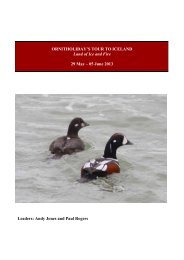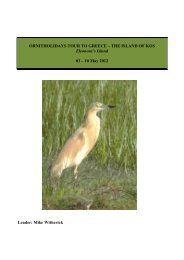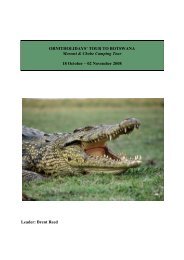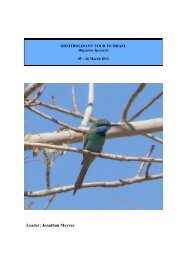Download 2014 Brochure (.pdf) - Ornitholidays
Download 2014 Brochure (.pdf) - Ornitholidays
Download 2014 Brochure (.pdf) - Ornitholidays
You also want an ePaper? Increase the reach of your titles
YUMPU automatically turns print PDFs into web optimized ePapers that Google loves.
F R A N C E<br />
White-throated Dipper<br />
Gull, Little Tern, Pied Avocet and Kentish Plover.<br />
Careful searching might also give us a rarer gull,<br />
tern or wader, whilst Spectacled Warbler can be<br />
found in the Salicornia scrub. As we drive slowly on<br />
the quiet lanes, we should find the exotic European<br />
Bee-eater which nests in sandy banks, whilst<br />
Crested Lark and Black Kite are common<br />
throughout the area. To the east of the Camargue<br />
lies the stony plain of La Crau. The former delta of<br />
the Durance River, it provides a habitat found<br />
nowhere else in France. Special birds include<br />
Lesser Kestrel, Little Bustard, Stone Curlew, Pintailed<br />
Sandgrouse, Iberian Grey Shrike, Eurasian<br />
Hoopoe, Greater Short-toed Lark and Tawny Pipit.<br />
On a calm day a stroll on the reserve of Peau de<br />
Meau provides an unforgettable experience, with<br />
the flora and avifauna complemented by a range<br />
of butterflies including Swallowtail and Western<br />
Marbled White. The adjacent canal is the top<br />
dragonfly spot in Provence and we hope to find<br />
Copper Demoiselle, Norfolk Hawker and<br />
Mediterranean Damselfly.<br />
There is much to see in the Camargue, and the<br />
Crau, but there should also be time for a short<br />
visit to the nearby range of hills, Les Alpilles. We<br />
can stop to admire the historic village and castle<br />
of Les Baux, whilst nearby Subalpine and<br />
Dartford Warblers breed in the scrub and both<br />
Bonelli’s and Short-toed Eagles can be found<br />
soaring along the cliffs.<br />
Days 5 to 7<br />
As we transfer to the Cévennes, our route takes<br />
us via Pont du Gard. The renowned Roman<br />
aqueduct is worth seeing in its own right, but it<br />
also provides the opportunity of seeing<br />
numerous Alpine Swifts and perhaps the<br />
unobtrusive Common Rock Sparrows or the<br />
local pair of European Honey Buzzards. From<br />
there, we head northwards to Alès before<br />
beginning the climb into the hills through floralrich<br />
pastures and fine deciduous woodlands.<br />
Our base for the next three nights is Le Pont de<br />
Montvert, located in the upper reaches of the<br />
River Tarn. White-throated Dipper, Grey Wagtail<br />
European Bee-eater<br />
and Eurasian Crag Martin can all be seen from<br />
the balconies of our rooms in Aux Sources du<br />
Tarn, another hotel noted for its fine cooking,<br />
whilst within walking distance the woods contain<br />
Firecrest, Short-toed Treecreeper and Western<br />
Bonelli’s Warbler.<br />
A short drive north of our hotel lies Mont Lozère<br />
where the open pines support Citril Finch,<br />
Crested Tit, Tree Pipit and Woodlark. Nearby,<br />
driving the splendidly deserted side roads will<br />
give us our first opportunity to see orchids and<br />
other flowering plants such as Wild Daffodils and<br />
Tulips. We search meadows in the adjacent<br />
valleys for butterflies, including numerous<br />
coppers, blues and fritillaries: exactly which<br />
species we see will depend on the weather and<br />
how advanced the season is. Red Kite, Rock<br />
Bunting and Black Woodpecker are amongst<br />
other birds within just a few miles of our base.<br />
West of Florac lies the Causse Méjean, bordered<br />
by the Gorge du Tarn and the Gorge de la Jonte.<br />
This rolling limestone upland plateau,<br />
surrounded by steep cliffs, is unique in France,<br />
and is noteworthy for its raptors including<br />
Montagu’s and Hen Harriers. Amongst the<br />
numerous Eurasian Griffon Vultures drifting up<br />
from the gorges we hope to find the much rarer<br />
Eurasian Black Vulture. Flocks of Red-billed<br />
Chough and pairs of Common Raven patrol the<br />
skies, whilst we have further chances of finding<br />
the colourful Rufous-tailed Rock Thrush. A stop<br />
for coffee at a well-positioned auberge will put us<br />
close to territories of Red-backed Shrike,<br />
Common Quail, Western Orphean Warbler and<br />
Eurasian Wryneck. Local knowledge should help<br />
us locate further interesting orchids, as well as<br />
yet more butterflies. Indeed, the eye may be so<br />
drawn to the flora and butterflies that, for a while<br />
in the middle of the day, the birds may be<br />
relegated to a back seat!<br />
Day 8<br />
We leave the hotel after breakfast and drive to<br />
Montpellier for our return flight to London.<br />
Outline Itinerary<br />
Day 1 Fly to Montpellier and<br />
transfer to Beaucaire<br />
Days 2-4 Beaucaire<br />
Days 5-7 Le Pont de Montvert<br />
Day 8 Depart Montpellier<br />
Party Size<br />
Maximum of 14 clients (two leaders with<br />
more than seven clients).<br />
Accommodation<br />
Comfortable accommodation in twin/double<br />
and single rooms, with private facilities.<br />
Transport<br />
By minibuses driven by the leaders.<br />
Includes<br />
All flights, meals, accommodation, transport,<br />
entry fees, services of the leaders, VAT,<br />
airport taxes and tips.<br />
Gradings<br />
Good<br />
140<br />
Warm<br />
Low<br />
Normal<br />
Swallowtail<br />
Relaxed<br />
Good<br />
Easy<br />
Scheduled<br />
To make a booking please call <strong>Ornitholidays</strong> on 01794 519445<br />
129








